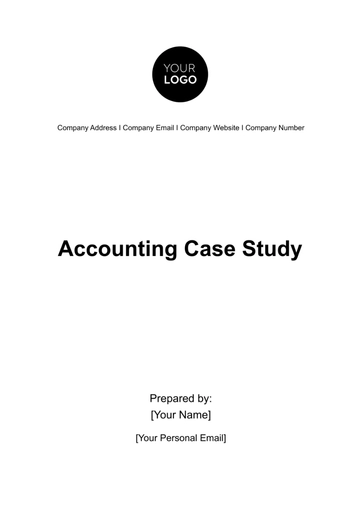Free Accounting Company Accounts

I. Introduction
This document outlines the structure, management, and reporting of accounts within [Your Company Name], an accounting firm. It provides a detailed overview of the different types of accounts maintained by the firm, their purposes, and the procedures for managing and reporting these accounts. The aim is to ensure clarity and accuracy in financial management, thereby supporting the firm's operational efficiency and financial stability.
II. Account Types and Management
Understanding the different types of accounts is crucial for effective financial management. This section categorizes the various accounts maintained by [Your Company Name] and describes the processes for managing each type. Proper management of these accounts ensures accurate financial reporting and compliance with regulatory standards.
A. Asset Accounts
Asset accounts represent the resources owned by the firm that have economic value and can be converted into cash. These include current assets like cash and accounts receivable, as well as non-current assets such as property and equipment. Asset accounts are updated regularly to reflect purchases, disposals, and depreciation. Periodic reconciliations are performed to ensure accuracy and completeness of asset records.
Asset Type | Opening Balance | Additions | Disposals | Ending Balance |
|---|---|---|---|---|
Cash | $500,000 | $200,000 | $50,000 | $650,000 |
Accounts Receivable | $300,000 | $400,000 | $100,000 | $600,000 |
Equipment | $1,000,000 | $150,000 | $200,000 | $950,000 |
Property | $2,000,000 | $0 | $0 | $2,000,000 |
The asset accounts show a healthy increase in cash and accounts receivable, indicating strong operational activity. The equipment account decreased due to disposals, which may require further review for potential upgrades or replacements.
B. Liability Accounts
Liability accounts represent the firm's obligations or debts that need to be settled in the future. These include current liabilities like accounts payable and long-term liabilities such as loans. Liability accounts are monitored to ensure timely payments and accurate reporting of outstanding obligations. Regular reviews and reconciliations help manage and reduce potential financial risks.
Liability Type | Opening Balance | Additions | Payments | Ending Balance |
|---|---|---|---|---|
Accounts Payable | $250,000 | $300,000 | $200,000 | $350,000 |
Long-Term Loans | $500,000 | $100,000 | $150,000 | $450,000 |
Taxes Payable | $100,000 | $50,000 | $75,000 | $75,000 |
The liability accounts indicate an increase in accounts payable and long-term loans, which suggests higher operational and financing activities. The decrease in taxes payable reflects timely tax payments, which is a positive indicator of compliance.
C. Equity Accounts
Equity accounts represent the owners’ interest in the firm’s assets after all liabilities have been settled. These include common stock, retained earnings, and additional paid-in capital. Equity accounts are updated based on profits, distributions, and additional investments. Regular monitoring ensures that equity is accurately reported and any changes are properly documented.
Equity Type | Opening Balance | Additions | Withdrawals | Ending Balance |
|---|---|---|---|---|
Common Stock | $1,000,000 | $0 | $0 | $1,000,000 |
Retained Earnings | $800,000 | $300,000 | $0 | $1,100,000 |
Additional Paid-In Capital | $200,000 | $50,000 | $0 | $250,000 |
The increase in retained earnings indicates positive profitability, while the common stock and additional paid-in capital remain stable. This reflects a solid financial foundation and potential for growth.
III. Financial Reporting
Financial reporting involves preparing and presenting financial statements that accurately reflect the firm's financial position and performance. This section outlines the processes and schedules for generating these reports, ensuring transparency and compliance with accounting standards.
A. Monthly Financial Reports
Monthly financial reports provide an overview of the firm's financial performance and position. These reports include the income statement, balance sheet, and cash flow statement. Financial reports are prepared at the end of each month, reviewed for accuracy, and distributed to management. Any discrepancies are addressed promptly, and reports are archived for future reference.
B. Quarterly and Annual Financial Statements
Quarterly and annual financial statements offer more detailed insights into the firm’s financial performance over longer periods. These statements are used for strategic planning and compliance with regulatory requirements. These statements are compiled from the monthly reports and additional year-end adjustments. They are audited by an external auditor before being presented to stakeholders.
Report Type | Frequency | Distribution Date |
|---|---|---|
Monthly Financial Reports | Monthly | 5th of Each Month |
Quarterly Financial Statements | Quarterly | 15th of the Month |
Annual Financial Statements | Annually | 31st January |
The timely preparation and distribution of financial reports ensure that management and stakeholders have access to up-to-date information. Regular audits and adjustments maintain the accuracy and reliability of financial statements.
IV. Compliance and Regulation
Adherence to accounting standards and regulatory requirements is essential for maintaining the firm's credibility and avoiding legal issues. This section describes the compliance measures in place and the procedures for ensuring that all accounting practices meet regulatory standards.
A. Internal Controls
Internal controls are policies and procedures designed to safeguard the firm's assets and ensure the accuracy of financial reporting. Effective controls help prevent fraud and errors. Regular reviews and updates of internal controls are conducted to address any weaknesses. Staff training on compliance and ethics further supports these controls.
B. External Audits
External audits involve an independent review of the firm’s financial statements and accounting practices. These audits provide an objective assessment of financial accuracy and compliance. External auditors are engaged annually to review financial statements. The audit results are reviewed by management, and any recommendations for improvements are implemented.
Compliance Area | Status | Last Review Date | Next Review Date |
|---|---|---|---|
Internal Controls | Compliant | [Month Day, Year] | [Month Day, Year] |
External Audits | Scheduled | [Month Day, Year] | [Month Day, Year] |
Regulatory Filings | On Track | [Month Day, Year] | [Month Day, Year] |
The compliance and regulation measures are well-managed, with regular reviews and audits ensuring adherence to standards. The status indicates that the firm is on track with its compliance obligations.
V. Budgeting and Forecasting
Budgeting and forecasting are vital for planning and managing the firm’s financial resources. This section outlines the budgeting process, forecasting methods, and the tools used to project future financial performance.
A. Budget Preparation
Budget preparation involves estimating future revenues and expenses to guide financial decision-making. A well-prepared budget helps allocate resources efficiently and achieve financial goals. Budget requests are collected from various departments, reviewed, and consolidated into an overall budget. The budget is approved by senior management and monitored throughout the year.
Department | Budgeted Amount | Actual Amount | Variance |
|---|---|---|---|
Marketing | $500,000 | $480,000 | $20,000 |
Operations | $1,000,000 | $1,020,000 | ($20,000) |
HR | $300,000 | $290,000 | $10,000 |
IT | $200,000 | $210,000 | ($10,000) |
The budget allocation shows minor variances, with marketing and HR departments under budget, while operations and IT are slightly over budget. These variances should be reviewed for potential adjustments.
B. Financial Forecasting
Financial forecasting involves projecting future financial outcomes based on historical data and market trends. Accurate forecasts help in strategic planning and resource allocation. Historical financial data and market analysis are used to create forecasts. These forecasts are reviewed periodically and adjusted as necessary to reflect changing conditions.
Quarter | Projected Revenue | Actual Revenue | Variance |
|---|---|---|---|
Q1 | $750,000 | $740,000 | $10,000 |
Q2 | $800,000 | $810,000 | ($10,000) |
Q3 | $850,000 | $860,000 | ($10,000) |
Q4 | $900,000 | $880,000 | $20,000 |
The revenue forecast indicates that actual revenues closely match projections, with slight variances. These forecasts will help guide future financial strategies and adjustments.
VI. Next Steps
The next steps section outlines the actions required to build on the current accounting practices and address any identified issues. It provides a roadmap for improving financial management and ensuring continued success.
Review Variances and Adjust Budgets: Analyze the variances between budgeted and actual amounts, and adjust future budgets accordingly to address any discrepancies.
Implement Recommended Improvements from Audits: Review audit recommendations and implement changes to internal controls and financial reporting processes.
Enhance Financial Forecasting Methods: Update forecasting models to incorporate the latest market trends and historical data for more accurate projections.
Strengthen Compliance Training: Provide additional training for staff on compliance and internal controls to reinforce adherence to regulations.
[Your Company Name] has effectively managed its accounting operations with robust processes for financial reporting, compliance, and budgeting. The firm’s commitment to accuracy and transparency supports its overall financial stability and operational efficiency. Future improvements will focus on addressing identified variances and enhancing financial forecasting practices.
- 100% Customizable, free editor
- Access 1 Million+ Templates, photo’s & graphics
- Download or share as a template
- Click and replace photos, graphics, text, backgrounds
- Resize, crop, AI write & more
- Access advanced editor
Manage company finances effectively with our Accounting Company Accounts Template from Template.net. Fully customizable and editable, this template provides a comprehensive layout for tracking financial statements. Easily personalize the template, editable in our Ai Editor Tool, to meet your accounting requirements. Ensure accurate and organized financial management with a professional accounts template.




























